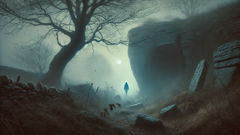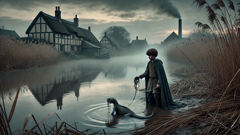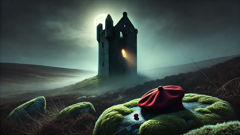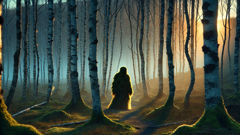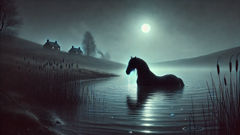Introduction
Fog sat in the folds of the Leicestershire countryside like an old shawl left to dampen and cool. Hedges stitched fields to one another with dark, thorned seams; wayside oaks crouched in their own patience; hollow lanes kept secrets the children avoided after dusk. The story of the Black Annis belonged to those seams and hollows. It rode in the shiver that traveled a child's sleeve when mothers called their youngsters home and in the deliberate silence of men who had been too close to the moor. People spoke of a blue face, as if someone had mixed winter sky with bruises and painted a woman there, of a mouth that gaped with hunger and teeth that flashed like flint, and of three-fingered hands tipped with iron claws that could rake the bark from a yew tree and the bone from a shoulder. They claimed her den was a cleft of gritstone, a kind of cave pitted with the weather of centuries, and that she marked the nearest rough track with stones scattered like warnings. I grew up amid these fields, listening, and I learned that the Black Annis was never merely a story to frighten misbehaving children. She was a name tied to place, a cautionary mnemonic about the fractious balance between the community and the wild places around it. In the months when hedgerows bled their last leaves and frost sat white on the rails, villagers would draw curtains tight, leave spilt milk on the doorstep for luck, and whisper the old words of warding. And yet, if you followed the hollow lane to where the ground dropped and the wind had hollowed a throat in the rock, and if you were patient and small enough not to be noticed, you might glimpse a silhouette against the cave mouth—an animal shape, a hunched woman, or nothing at all. This Tale of the Black Annis is a retelling: a careful gathering of fragments, memory, landscape, and rumor, stitched together to show how a blue-faced hag with claws of iron can be at once a mirror of human fear, a ghost of farmland hardship, and a living hinge between the cultivated and the feral.
Of Hedges, Hearths, and the First Accounts
The earliest recorded whispers about the Black Annis are woven into parish memory and hearthside gossip rather than ink. Before the county registers and printed broadsides, the story resided in speech: half lines muttered over churns, warnings passed at market, and names wrapped into gossip like a potter knots twine around a jug. To understand how the tale grew, you must imagine a village economy held close to the land, where a failed lamb meant hunger and an outlying child must learn quickly which wild hens could be left to the hawks. The Black Annis was useful as a social instrument—an embodiment of danger, an explanation for things that had no softer answer. But she was more than an instrument; she was a figure shaped by a particular geography and the rhythms of subsistence that bent every household toward caution.
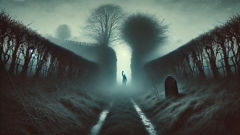
Look at the hedgerows in Leicestershire and you will see the ingredients of her story: gorse and hawthorn, bramble and elder, their roots holding stones loosened from the underlying bedrock. Those stones were once quarried for doorways and milestones; others fell into the gullies and formed small, dark caves and clefts where a ewe might shelter or where, in wet years, humans would hide a newly born lamb. These hollows became the Black Annis's supposed lair. People reported the sight of a blue face at the cave mouth—a face not simply tinted with the cold but as if painted by a hand that knew how to make the living look inhuman. Reports varied: an old woman with a coal-streaked bonnet, a great monstrous creature, a tangle of gray hair and ragged skirts. The claws—iron, they said—are perhaps the most tenacious detail. Iron is the worker's metal; scythes, sickles, nails—objects of toil and defense. When stories ascribe iron to a creature's claws, they liken the wild to the tools of human labor. They also give weight to the threat. Iron claws tear, they do not merely scratch; they strip, expose, and leave a permanence in the world that folk feared.
But why blue? Blue in the vernacular palette of the countryside is associated with bruises, with winter’s wan pallor, and with an old dye that stained hands through the years—indigo and woad used in cloth making, smudges on the skin of workers who wove and mended. Perhaps the blue-face told of someone shunned and turned outward by village life, or it was an emblematic color of otherworldliness. In oral performance, color is shorthand for moral orientation: a blue face marks the stranger, the outsider, the weathered person who does not fit in. In a region where parish records show episodic periods of famine, displacement, and the constant pressure of rent and tithes, the Black Annis might be read as a form of social memory, the unloved and feared materialized.
There are recorded anecdotes in the 18th and 19th centuries that attempt to catalogue her actions. One version tells of a shepherd who lost a child of his own and blamed the Black Annis for the disappearance of a neighbor's infant. Another claims a gaoler's iron gauntlets were found in the cleft—an explanatory artifact that made the tale tactile. More pragmatic accounts from vicars and magistrates cast doubt and labeled the stories as superstition meant to frighten children into obedience. Yet villagers continued to tell them, to mark their lands and to set stones along paths that the tale designated as dangerous. Names stuck to place: Annis's Hole, or Old Woman's Hollow, or the cleft near the fields of Stretton where the light seemed to go a shade darker even in noon. Through that naming, landscape and narrative conjoined. Place gave the tale a fixedness and the tale, in turn, endowed the place with moral geography.
The Black Annis also functioned as a boundary guardian of sorts. In agrarian communities, boundaries mattered—physical fences and invisible social rules kept order. A belief in a creature that punished the unwary kept people from wandering at night into bogs, from stealing from neighboring fields, from neglecting customs of care for the young. When the story is told in this light, the hag becomes complex: she is predator and pedagogue, terrifying yet oddly integral to the community’s survival. The image of her iron claws acts as an almost juridical instrument—a punishment meted by the land itself. Stories of children being carried away or of women taken in the deep hours carry a double reading: a monstrous abductor, yes; but also an allegory for the peril of neglect, abandonment, or crossing communal bounds. They encode social rules into images that are memorable and repeatable.
What is striking in the found fragments is the elasticity of the Black Annis. She is sometimes a solitary crone, sometimes an animistic presence, sometimes an amalgam of local misfortunes. Her persistent feature—aside from the blue face and iron claws—is her association with the hollow and with the seasons when the vulnerability of rural life is loudest: lambing, harvest lean years, long wet winters. The story flexes to contain anxieties about childbirth, about taking what does not belong to you, and about the wildness that presses close to cultivated land. The Black Annis shaped how people read odd noises in the hedgerow, how they rationalized missing goods, and how they articulated the ineffable sorrow of loss, all the while granting a certain catharsis. By giving the unnamed and incomprehensible a form—a crone with iron fingers—people could gossip, warn, ritualize, and reckon with the sharp edges of existence.
There are cruelties in the versions that persist; tales of hung carcasses hung against the cave mouth to distract or appease, of offerings left on the verge in hopes the creature would sleep and leave the children alone. Those acts reveal the moral calculus: to perform a small, shameful generosity to a monster might save a life. Other acts reveal communal aggression: villagers considering burning the cleft, or laying snares, or driving dogs trained to scent out such evils. The Black Annis, then, exists in a network of responses: fear, appeasement, and attempted eradication. Each response tells us more about the people who told the tale and less about any single, fixed version of the creature herself. Oral tradition kept the tale malleable; each teller adjusted the tale to suit a new season, a new fear, a new child.
To read the Black Annis in history is to see how folklore is sedimentary: layers of subsistence, grief, power relations, and the texture of place press together into a single story. It is to see that the blue face and iron claws are not arbitrary details but meaningful emblems of a landscape and a people. They functioned as markers of danger, social cohesion, and moral instruction. They were also, when you listen to the whispers between the market stalls and the church porch, a dark sort of compassion—for in the very telling of the tale is a strange attention to the vulnerable and the wild, a way that people kept their young close and their boundaries visible. The Black Annis, haunting the hedgerows and hollow lanes, is a creature of caution and a mirror of human choices, and her story is an instrument both of dread and of communal memory.
Encounters, Echoes, and the Enduring Image
The Black Annis retained her grip in local memory through accounts that were never entirely consistent. Encounters were embroidered with personal emphasis but always returned to core images: blue skin, iron claws, a cavernous lair. The retellings differ in tone—sometimes the hag is grotesque, sometimes pitiful—and these differences tell us about the changing anxieties of rural Leicestershire over centuries.
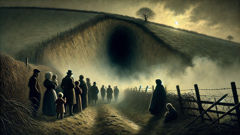
One popular account tells of a night watchman walking home from the alehouse who, taking a short-cut through the fields, encountered a low rattle as if pebbles were being thrown gently at the hedgerow. The watchman paused, hands on his staff. A blue glow moved at the mouths of a stone hollow. He shouted and the light vanished, leaving only a scent like cold ash. The watchman’s wife swore he returned with a new wariness and a streak of silver in his hair within a season. Another tale speaks of a group of boys who dared one another to fetch a clutch of eggs from a farmstead beside the cave. They returned with none and told different stories: one swore he had seen a hand with iron claws, another that he had heard a lullaby that made him want to sleep, and a third that he woke in a ditch with muddy knees and no recollection of the hour. These variations show how memory, fear, and imagination braided together; each narrator reconstructed the night to fit his own temperament.
In Victorian collections and newspapers, the Black Annis became grist for antiquarian speculation. Writers who prized cataloguing the strange took her as a relic of an older cosmology, drawing parallels with other European hag-figures: the crone of the wood, the hut-dweller of northern myth, the ravenous witch of continental lore. Some posited that Black Annis was a survival of pre-Christian nature spirits, a last echo of animism in an increasingly ordered society. Others insisted she was a cautionary creation of parents and priests meant to enforce social mores. The way she was discussed in print demonstrates the period’s hunger for classification and its anxiety about the rural past disappearing under industrialization’s advance. As railways cut swathes across the countryside and markets became centralized, such creatures were either romanticized or demonized, rarely allowed to remain simply local and immediate.
Artists and poets occasionally seized upon the vividness of the image. Drawings and woodcuts from the early 19th century show a hunched, monstrous figure with exaggerated claws and a grotesque face. These images pushed the Black Annis away from ambiguity and toward caricature. A folk figure that could once have been rendered with the trembling restraint of oral performance was solidified into a new public image. As public perception hardened, the narrative function of the hag shifted: from a useful, mutable caution to a more sensational curiosity. That change altered the way communities related to the story; where earlier it might have structured behavior, now it was increasingly an object of entertainment, a roadside anecdote for tourists passing through the county. Yet even in this transformation the core symbol remained powerful: the idea of a female figure who embodied fear and the wild would not be erased by commercialization.
Modern retellings also show how gendered anxieties shaped the legend. The Black Annis is a woman-shaped locus for multiple male and female fears—the ungentle mother, the devouring crone, the widowed laborer who resented the village. The narrative is uncomfortable because it externalizes domestic conflict into the figure of a monstrous woman. Stories in which she carries off children echo domestic tensions and social stigmas—those about women who do not conform, who are old, barren, or otherwise marked by misfortune. At times the story punishes transgressors: those who steal or who stray are taken by the hag. That punishment is a kind of moral arithmetic, a way to reinforce communal norms where law and enforcement were distant or unreliable.
Yet some versions also paint her with tenderness, a strange inversion where the Black Annis is a guardian of the wild more than a mere predator. In these accounts she protects certain corners of the hedgerow from careless plunderers and teaches the price of taking more than the land can spare. A woman who tended an outlying patch of herbs and who once tended a bereaved child remembered leaving milk and bread at the cleft and finding, later, a small arrangement of bones and feathers—offerings she interpreted as a caution rather than malice. This tenderness suggests that the figure of Black Annis could be a repository for respect toward the ungoverned parts of the landscape, marking a threshold where human appropriation becomes sacrilege.
The iron claws are an image that stayed because they grounded the imagination in something concrete. In an agricultural world, iron implements shaped daily life; for a story to pick iron suggests the land pushes back with the tools men and women themselves use. Those claws imagine a landscape turned domestic tool; the wild borrows human agency to resist and to take. They provide an uncanny symmetry: we make iron to harvest and build, and in imagining claws of iron, we see ourselves mirrored in the threat. Such mirroring is unsettling and useful. It forces a reconsideration of the line between human cruelty and natural peril. When the hag rakes with iron, she acts with the logic of machines and men, and in that act the community sees its own hand in the harm it fears.
Across time, the Black Annis's tale has been rewoven: a local superstition, an aesthetic object, a moral primer, and a cultural emblem. The figure endures in place-names and in the way hedgerows are still watched by older villagers on winter evenings. Even when modern explanations—foxes, wolves long since extirpated, or simple mischief—are plausible, the image persists. It persists because stories like hers are sticky; they name the dark, give shape to loss, and teach with a clarity more durable than admonition alone. In telling and retelling, a community keeps its edges, marks its rules, and holds the wild at bay with a line shaped as much by narrative as by fence. That is why, beneath the noise of modern life, the Black Annis can still be heard in a rustle behind the hedge or in an old woman's warning. She is a sound the countryside makes when it remembers its own precariousness, a blue-faced mirror held up to the lives folded into the fields.
If you travel now to those hedgerows and find a rock cleft in the right place, you may or may not feel the old compulsion to treat it differently. You may set a polite offering and feel foolish, you may ignore it with the confident disbelief of city-raised travelers, or you may pause and imagine the weight of all the evenings when people whispered the name to keep their children close. The encounter has less to do with the supernatural and more to do with an inherited attentiveness. The Black Annis compels us to remember the landscape as sentient, that is, as a repository of social meaning that demands care. In the image of the hag, a community stored its anxieties and its small, essential rules. Those rules are not merely quaint; they are an archive of rural survival strategies—always mediated through story, sometimes savage, sometimes tender, but always instructive.
Conclusion
The Tale of the Black Annis does not end with a single truth but with a ledger of human responses to a landscape that could be both provider and threat. Over centuries, the blue-faced hag with iron claws became a palimpsest of anxieties and comforts: a figure used to enforce boundaries, to teach caution, and to give narrative form to grief and hunger. She reminds us that folklore is not simply entertainment but a practical technology for living—an embodied warning and an architecture of communal memory. In Leicestershire, hedgerows and hollow lanes still hold traces of those stories; they are the lines village life drew to keep the small and vulnerable within reach. Whether imagined as monster or guardian, Black Annis is a testament to how communities name danger and make room for the wild, and how, in naming, they sometimes find a strange tenderness. Visit the hollow and you will find a place where stone meets root and where the wind still carries the old words. You will also find that stories endure not because they are simple lies but because they are useful truths: compact, vivid, and designed to be shared at the end of day when shadows grow and the world seems, for a while, unmade.

